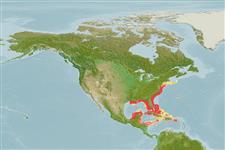Actinopterygii (ray-finned fishes) >
Pleuronectiformes (Flatfishes) >
Cynoglossidae (Tonguefishes) > Symphurinae
Etymology: Symphurus: Greek, syn, symphysis = grown together + Greek, oura = tail (Ref. 45335).
Environment / Climate / Range
Ecology
Marine; brackish; demersal; depth range 0 - 183 m (Ref. 26268), usually 1 - 30 m (Ref. 26268). Subtropical, preferred ?; 45°N - 15°N, 94°W - 65°W (Ref. 26268)
Western Atlantic: New York south through the Florida Keys (USA), through the northern Gulf of Mexico to the Campeche Peninsula, Mexico, the Bahamas, and Cuba.
Length at first maturity / Size / Weight / Age
Maturity: Lm 10.1 range ? - ? cm
Max length : 21.0 cm TL male/unsexed; (Ref. 52683)
Dorsal
soft rays
(total): 85-92;
Anal
soft rays: 69 - 72. Eyed side dark brown, sometimes with narrow bars; large blackish patch on opercle.
Very abundant in shallow coastal waters and estuaries. Found on soft muddy bottoms. Feeds mainly on small benthic invertebrates, principally small crabs, polychaetes, copepods, amphipods and ostracods.
Life cycle and mating behavior
Maturity | Reproduction | Spawning | Eggs | Fecundity | Larvae
Robins, C.R. and G.C. Ray, 1986. A field guide to Atlantic coast fishes of North America. Houghton Mifflin Company, Boston, U.S.A. 354 p. (Ref. 7251)
IUCN Red List Status (Ref. 115185)
CITES (Ref. 94142)
Not Evaluated
Threat to humans
Harmless
Human uses
Fisheries: minor commercial
Tools
Special reports
Download XML
Internet sources
